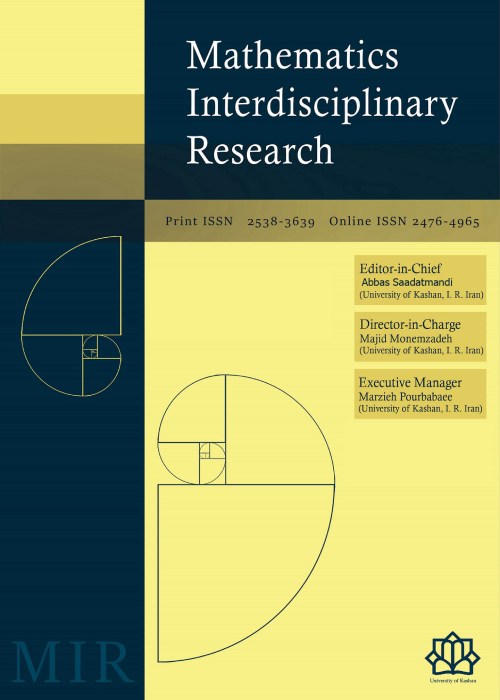فهرست مطالب
Mathematics Interdisciplinary Research
Volume:3 Issue: 2, Autumn 2018
- تاریخ انتشار: 1397/09/10
- تعداد عناوین: 11
-
-
Pages 75-79
-
Pages 81-87
Using the idea behind the Tillich-Zémor hash function, we propose a new hash function. Our hash function is parallelizable and its collision resistance is implied by a hardness assumption on a mathematical problem. Also, it is secure against the known attacks. It is the most secure variant of the Tillich-Zémor hash function until now.
Keywords: The Tillich-Zémor hash function, Cayley hash function, speciallinear group -
Pages 89-98
Suppose G is a group of order p^2q^2 where p>q are prime numbers and suppose P and Q are Sylow p-subgroups and Sylow q-subgroups of G, respectively. In this paper, we show that up to isomorphism, there are four groups of order p^2q^2 when Q and P are cyclic, three groups when Q is a cyclic and P is an elementary ablian group, p^2+3p/2+7 groups when Q is an elementary ablian group and P is a cyclic group and finally, p + 5 groups when both Q and P are elementary abelian groups.
Keywords: Semi-direct product, p-group, Sylow subgroup -
Pages 99-108
In this paper, we first present some properties of lower and upper central series of pair of groups. Then the notion of $n$-isoclinism for the classification of pairs of groups is introduced, and some of the structural properties of the created classes are proved. Moreover some interesting theorems such as Baer Theorem, Bioch Theorem, Hirsh Theorem for pair of groups are generalized. Finally, it is shown that each $n$-isoclinism family of pairs contains a quotient irreducible pair.
Keywords: n-Isoclinism, pair of groups, quotient irreducible pair, π-groups -
Pages 109-115
for a finite group G, we denote by p (G) the minimal degree of faithful permutation representations of G, and denote by c (G), the minimal degree of faithful representation of G by quasi-permutation matrices over the complex field C. In this paper we will assume that, G is a p-group of exponent p and class 2, where p is prime and cd (G) = {1, |G : Z (G)|^1/2}. Then we will show that c (G)≤ |G : Z (G)|^{1/2} c (Z (G)) , p (G) ≤ |G : Z(G)|^{1/2}p (Z (G)):
Keywords: Quasi-permutation, linear character, non-linear character -
Pages 117-129
The purpose of this paper is to compute of fundamental relations of hypergroups. In this regards first we study some basic properties of fundamental relation of hypergroups, then we show that any given group is isomorphic to the fundamental group of a nontrivial hypergroup. Finally we study the connections between categories of hypergroups and groups via the fundamental relatio
Keywords: Group, hypergroup, fundamental relation, category -
Pages 131-134
In this paper, we prove that every semi-Cayley graph over a group G is quasi-abelian if and only if G is abelian.
Keywords: Semi-Cayley graph, quasi-abelian, semi-regular -
Pages 135-138
The (undirected) power graph on the conjugacy classes $mathcal{P_C}(G)$ of a group $G$ is a simple graph in which the vertices are the conjugacy classes of $G$ and two distinct vertices $C$ and $C'$ are adjacent in $mathcal{P_C}(G)$ if one is a subset of a power of the other. In this paper, we describe groups whose associated graphs are $k$-regular for $k=5,6$.
Keywords: Power graph, finite group, conjugacy class -
Pages 139-146
The aim of this paper is to classify all monogenic ternary semigroups, up to isomorphism. We divide them to two groups: finite and infinite. We show that every infinite monogenic ternary semigroup is isomorphic to the ternary semigroup O, the odd positive integers with ordinary addition. Then we prove that all finite monogenic ternary semigroups with the same index and the same period are isomorphic. We also investigate structure of finite monogenic ternary semigroups and we prove that any finite monogenic ternary semigroup is isomorphic to a quotient ternary semigroup.
Keywords: Ternary semigroup, monogenic ternary semigroup, index, period -
Pages 147-158
In this paper, we consider the projective special linear group $PSL_2 (59)$ and construct some 1-designs by applying the Key-Moori method on $PSL_2 (59)$. Moreover, we obtain parameters of these designs and their automorphism groups. It is shown that $PSL_2 (59) $ and $PSL_2 (59):2$ appear as the automorphism group of the constructed designs.
Keywords: Design, automorphism group, projective special linear group -
Pages 159-171
In this paper we determine the structure of (c,1,...,1) polynilpotent multiplier of certain class of groups. The method is based on the characterizing an explicit structure for the Baer invariant of a free nilpotent group with respect to the variety of polynilpotent groups of class row (c,1,...,1).
Keywords: Baer invariant, nilpotent product, basic commutator


